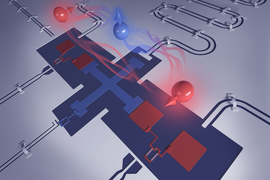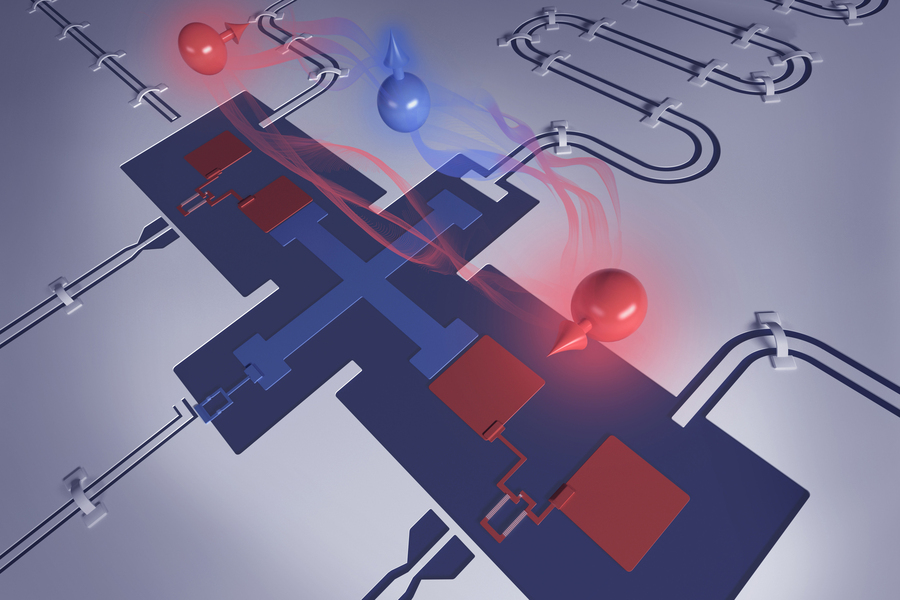In the future, quantum computers may be able to solve problems that are far too complex for today’s most powerful supercomputers. To realize this promise, quantum versions of error correction codes must be able to account for computational errors faster than they occur.
However, today’s quantum computers are not yet robust enough to realize such error correction at commercially relevant scales.
On the way to overcoming this roadblock, MIT researchers demonstrated a novel superconducting qubit architecture that can perform operations between qubits — the building blocks of a quantum computer — with much greater accuracy than scientists have previously been able to achieve.
They utilize a relatively new type of superconducting qubit, known as fluxonium, which can have a lifespan that is much longer than more commonly used superconducting qubits.
Their architecture involves a special coupling element between two fluxonium qubits that enables them to perform logical operations, known as gates, in a highly accurate manner. It suppresses a type of unwanted background interaction that can introduce errors into quantum operations.
This approach enabled two-qubit gates that exceeded 99.9 percent accuracy and single-qubit gates with 99.99 percent accuracy. In addition, the researchers implemented this architecture on a chip using an extensible fabrication process.
“Building a large-scale quantum computer starts with robust qubits and gates. We showed a highly promising two-qubit system and laid out its many advantages for scaling. Our next step is to increase the number of qubits,” says Leon Ding PhD ’23, who was a physics graduate student in the Engineering Quantum Systems (EQuS) group and is the lead author of a paper on this architecture.
Ding wrote the paper with Max Hays, an EQuS postdoc; Youngkyu Sung PhD ’22; Bharath Kannan PhD ’22, who is now CEO of Atlantic Quantum; Kyle Serniak, a staff scientist and team lead at MIT Lincoln Laboratory; and senior author William D. Oliver, the Henry Ellis Warren professor of electrical engineering and computer science and of physics, director of the Center for Quantum Engineering, leader of EQuS, and associate director of the Research Laboratory of Electronics; as well as others at MIT and MIT Lincoln Laboratory. The research appears today in Physical Review X.
A new take on the fluxonium qubit
In a classical computer, gates are logical operations performed on bits (a series of 1s and 0s) that enable computation. Gates in quantum computing can be thought of in the same way: A single qubit gate is a logical operation on one qubit, while a two-qubit gate is an operation that depends on the states of two connected qubits.
Fidelity measures the accuracy of quantum operations performed on these gates. Gates with the highest possible fidelities are essential because quantum errors accumulate exponentially. With billions of quantum operations occurring in a large-scale system, a seemingly small amount of error can quickly cause the entire system to fail.
In practice, one would use error-correcting codes to achieve such low error rates. However, there is a “fidelity threshold” the operations must surpass to implement these codes. Furthermore, pushing the fidelities far beyond this threshold reduces the overhead needed to implement error correcting codes.
For more than a decade, researchers have primarily used transmon qubits in their efforts to build quantum computers. Another type of superconducting qubit, known as a fluxonium qubit, originated more recently. Fluxonium qubits have been shown to have longer lifespans, or coherence times, than transmon qubits.
Coherence time is a measure of how long a qubit can perform operations or run algorithms before all the information in the qubit is lost.
“The longer a qubit lives, the higher fidelity the operations it tends to promote. These two numbers are tied together. But it has been unclear, even when fluxonium qubits themselves perform quite well, if you can perform good gates on them,” Ding says.
For the first time, Ding and his collaborators found a way to use these longer-lived qubits in an architecture that can support extremely robust, high-fidelity gates. In their architecture, the fluxonium qubits were able to achieve coherence times of more than a millisecond, about 10 times longer than traditional transmon qubits.
“Over the last couple of years, there have been several demonstrations of fluxonium outperforming transmons on the single-qubit level,” says Hays. “Our work shows that this performance boost can be extended to interactions between qubits as well.”
The fluxonium qubits were developed in a close collaboration with MIT Lincoln Laboratory, (MIT-LL), which has expertise in the design and fabrication of extensible superconducting qubit technologies.
“This experiment was exemplary of what we call the ‘one-team model’: the close collaboration between the EQuS group and the superconducting qubit team at MIT-LL,” says Serniak. “It’s worth highlighting here specifically the contribution of fabrication team at MIT-LL — they developed the capability to construct dense arrays of more than 100 Josephson junctions specifically for fluxoniums and other new qubit circuits.”
A stronger connection
Their novel architecture involves a circuit that has two fluxonium qubits on either end, with a tunable transmon coupler in the middle to join them together. This fluxonium-transmon-fluxonium (FTF) architecture enables a stronger coupling than methods that directly connect two fluxonium qubits.
FTF also minimizes unwanted interactions that occur in the background during quantum operations. Typically, stronger couplings between qubits can lead to more of this persistent background noise, known as static ZZ interactions. But the FTF architecture remedies this problem.
The ability to suppress these unwanted interactions and the longer coherence times of fluxonium qubits are two factors that enabled the researchers to demonstrate single-qubit gate fidelity of 99.99 percent and two-qubit gate fidelity of 99.9 percent.
These gate fidelities are well above the threshold needed for certain common error correcting codes, and should enable error detection in larger-scale systems.
“Quantum error correction builds system resilience through redundancy. By adding more qubits, we can improve overall system performance, provided the qubits are individually ‘good enough.’ Think of trying to perform a task with a room full of kindergartners. That’s a lot of chaos, and adding more kindergartners won’t make it better,” Oliver explains. “However, several mature graduate students working together leads to performance that exceeds any one of the individuals — that’s the threshold concept. While there is still much to do to build an extensible quantum computer, it starts with having high-quality quantum operations that are well above threshold.”
Building off these results, Ding, Sung, Kannan, Oliver, and others recently founded a quantum computing startup, Atlantic Quantum. The company seeks to use fluxonium qubits to build a viable quantum computer for commercial and industrial applications.
“These results are immediately applicable and could change the state of the entire field. This shows the community that there is an alternate path forward. We strongly believe that this architecture, or something like this using fluxonium qubits, shows great promise in terms of actually building a useful, fault-tolerant quantum computer,” Kannan says.
While such a computer is still probably 10 years away, this research is an important step in the right direction, he adds. Next, the researchers plan to demonstrate the advantages of the FTF architecture in systems with more than two connected qubits.
“This work pioneers a new architecture for coupling two fluxonium qubits. The achieved gate fidelities are not only the best on record for fluxonium, but also on par with those of transmons, the currently dominating qubit. More importantly, the architecture also offers a high degree of flexibility in parameter selection, a feature essential for scaling up to a multi-qubit fluxonium processor,” says Chunqing Deng, head of the experimental quantum team at the Quantum Laboratory of DAMO Academy, Alibaba’s global research institution, who was not involved with this work. “For those of us who believe that fluxonium is a fundamentally better qubit than transmon, this work is an exciting and affirming milestone. It will galvanize not just the development of fluxonium processors but also more generally that for qubits alternative to transmons.”
This work was funded, in part, by the U.S. Army Research Office, the U.S. Undersecretary of Defense for Research and Engineering, an IBM PhD fellowship, the Korea Foundation for Advance Studies, and the U.S. National Defense Science and Engineering Graduate Fellowship Program.











